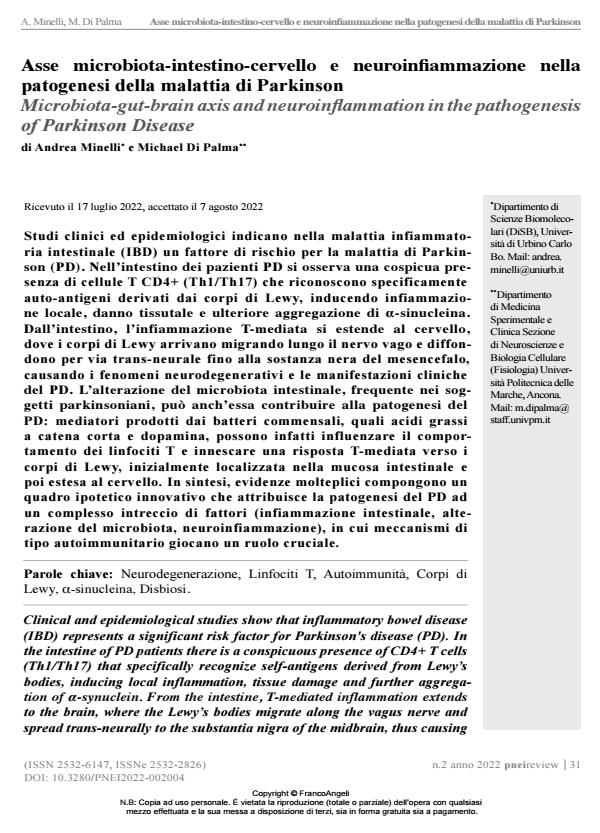Microbiota-gut-brain axis and neuroinfl ammation in the pathogenesis of Parkinson Disease
Journal title PNEI REVIEW
Author/s Andrea Minelli, Michael Di Palma
Publishing Year 2022 Issue 2022/2
Language Italian Pages 14 P. 31-44 File size 167 KB
DOI 10.3280/PNEI2022-002004
DOI is like a bar code for intellectual property: to have more infomation
click here
Below, you can see the article first page
If you want to buy this article in PDF format, you can do it, following the instructions to buy download credits

FrancoAngeli is member of Publishers International Linking Association, Inc (PILA), a not-for-profit association which run the CrossRef service enabling links to and from online scholarly content.
Clinical and epidemiological studies show that inflammatory bowel disease (IBD) represents a significant risk factor for Parkinson's disease (PD). In the intestine of PD patients there is a conspicuous presence of CD4+ T cells (Th1/Th17) that specifically recognize self-antigens derived from Lewy’s bodies, inducing local inflammation, tissue damage and further aggrega- tion of a-synuclein. From the intestine, T-mediated inflammation extends to the brain, where the Lewy’s bodies migrate along the vagus nerve and spread trans-neurally to the substantia nigra of the midbrain, thus causing neurodegeneration and clinical manifestations of the PD. The alteration of the intestinal microbiota, which is frequent in Parkinsonian subjects, can also contribute to the pathogenesis of PD: mediators produced by commen- sal bacteria, such as short-chain fatty acids and dopamine, can influence the behavior of T lymphocytes and trigger a T-mediated response towards Lewy’s bodies, initially localized in the intestinal mucosa and then exten- ded to the brain. In summary, growing evidence make up an innovative hypothetical framework that attributes the pathogenesis of PD to a complex interweaving of factors (intestinal inflammation, dysbiosis, neuroinflammation), in which autoimmune mechanisms play a crucial role.
Keywords: Neurodegeneration, T lymphocytes, Autoimmunity, Lewy’s bodies, a-synuclein, Dysbiosis.
Andrea Minelli, Michael Di Palma, Asse microbiota-intestino-cervello e neuroinfi ammazione nella patogenesi della malattia di Parkinson in "PNEI REVIEW" 2/2022, pp 31-44, DOI: 10.3280/PNEI2022-002004